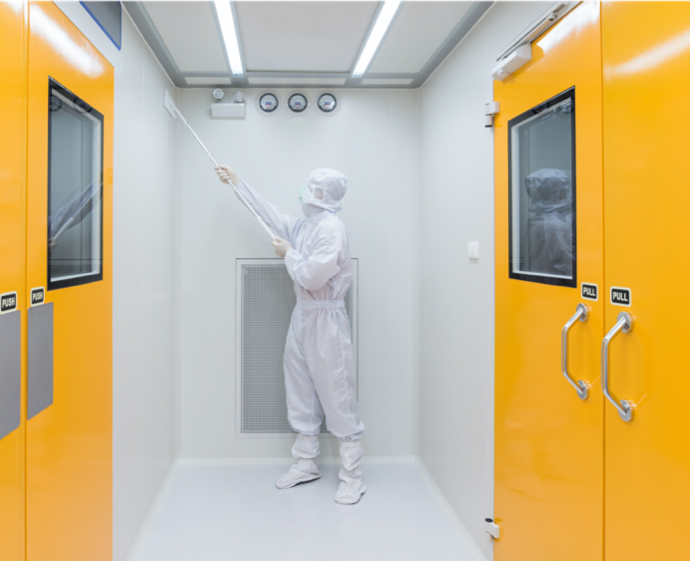Cleanrooms are intentionally designed to minimise environmental, product and personnel contamination risks. Once validated, it has been demonstrated (and documented) that the area is functioning as intended and is ready to support manufacturing activities with little risk of contamination.
Key control mechanisms for cleanrooms include restricted access, environmental monitoring systems, specific material, personnel and waste flows, air pressure cascades, engineering controls and procedures that explain how personnel should dress and interact with the space and equipment found within.
This article will review fundamental concepts of maintaining a validated cleanroom, including proper cleaning techniques and overcoming personnel issues.
Proper cleaning techniques
Once your cleanroom is built, balanced and validated, it is crucial to keep that environment clean. The process begins with personnel following the appropriate gowning procedures before entering the space.
Once operators are properly gowned, the best practice is to start cleaning in the cleanest area and work your way to the dirtiest. Cleaning programmes often rotate which types of cleaning agents are utilised on what timelines.
A three-step approach is common when a “deep” clean is needed, whether following a contamination event or as part of the normal cleaning cycle. An example three-step approach is as follows:
- clean all ceilings, walls, contact surfaces and floors with a surfactant
- clean all ceilings, walls, contact surfaces and floors with a disinfectant or sporicidal agent; leave the sporicidal agent on all surfaces for the dwell time defined in the product’s instructions
- rinse all ceilings, walls, contact surfaces and floors with a sanitiser (such as 70% isopropyl alcohol).
While conducting any cleaning approach, several factors help to outcome ensure a successful clean. For example, it is important that personnel carefully follow cleaning procedures to decrease microbial and cross-contamination risks.

Cleaning should be done from top to bottom and back to front in the following order: ceilings, walls, contact surfaces (door handles, tables, chairs, etc.), and floors. While cleaning, wiping should be done in a unidirectional path utilising the clean surface of an appropriate mop or non-shedding wipe.
Of course, proper cleaning techniques and procedures are just one part of keeping your cleanroom in a validated state. Equally important is the need to overcome personnel issues.
Overcoming personnel issues
We all know that people are the dirtiest components of any cleanrooms. Roughly 75% of contamination comes from humans. In fact, operators can shed 10 g of skin cells a day; during a 3–4-day period, this can amount to shedding an entire layer of skin.
Human skin is a significant source of bacteria that hosts micro-organisms and can transport dust and dirt. Ensuring that personnel follow proper gowning procedures will reduce the risk of contamination.
Additional personnel issues such as turnover and motivation are a significant but expected hurdle to overcome in any business. This turnover creates specific issues when it comes to the personnel who work in cleanroom spaces.
Frequent changes in personnel can impact the validated status of cleanrooms. Inexperienced personnel may not perform certain actions as instructed or interpret procedures and requirements slightly differently, which may negatively affect a process or product.
Turnover also affects veteran personnel as they often perform the double duties of production and training.
Another personnel cleanroom challenge is motivation — or lack thereof. Training programmes often focus on how to perform a task without explaining the why behind it.
Adult learners must understand how their daily activities tie into the company’s goals, including why their actions are so important. In the case of personnel training, not explaining the why can lead to
- Lack of ownership or agency in the process: without the appropriate process understanding, operators lack nuance. The operator may notice something wrong in each situation but, lacking the why (understanding), may hesitate to correct the situation.
- Lack of understanding criticality: people tend to rationalise when they’re given a task without explanation. This can lead to assumptions that something “isn’t that important,” when in fact the very opposite is true.
To overcome personnel issues, a successful training programme must be developed to maintain the cleanroom in its validated state. All cleanroom personnel should be regularly evaluated in terms of their capabilities and knowledge.
From there, gaps should be identified and critical learning objectives put in place for personnel based on their role. By doing so, operators are provided with the necessary tools to perform their job functions successfully.
For all incoming personnel, training needs to include a variety of methods and inputs to increase knowledge retention. Adults do not remember every detail the very first time they hear something, so repetition is essential to build consistency.

Trainees need to be provided with the tools for success, which will help motivation. Explaining why their activities are critical helps trainees to clearly understand how their daily activities have a direct relationship to product quality and patient safety.
Additionally, individuals should be empowered to always “do the right thing” by instilling a “quality first” mentality. Engaging and training personnel with a successful programme will contribute to decreased contamination and deviations, which will ultimately help cleanroom environments to remain in their validated state.
Maintain control
Loss of control of your cleanroom will be evident in the monitoring data, which includes personnel and environmental factors. Contamination from environmental factors can result from improper cleaning techniques, whereas contamination or deviations from personnel can derive from a lack of training or proper motivation.
Detailed procedures for these critical functions are essential for consistency in execution. Combining those with a strategic training programme that’s designed to set personnel up for success will only increase the ability of your cleanroom areas to maintain their validated state.
